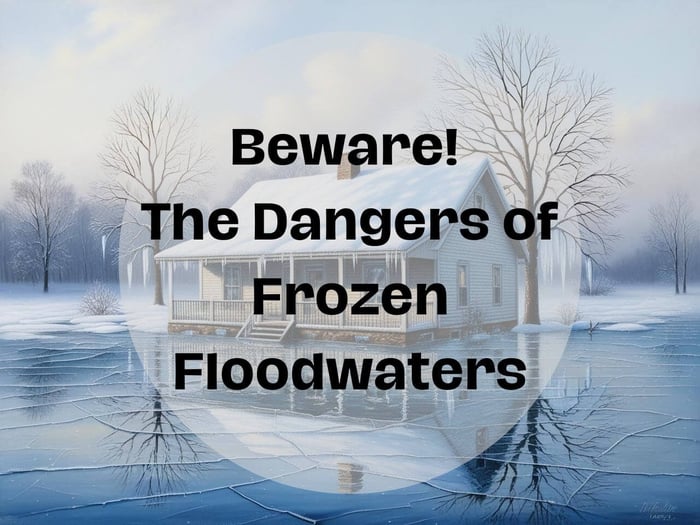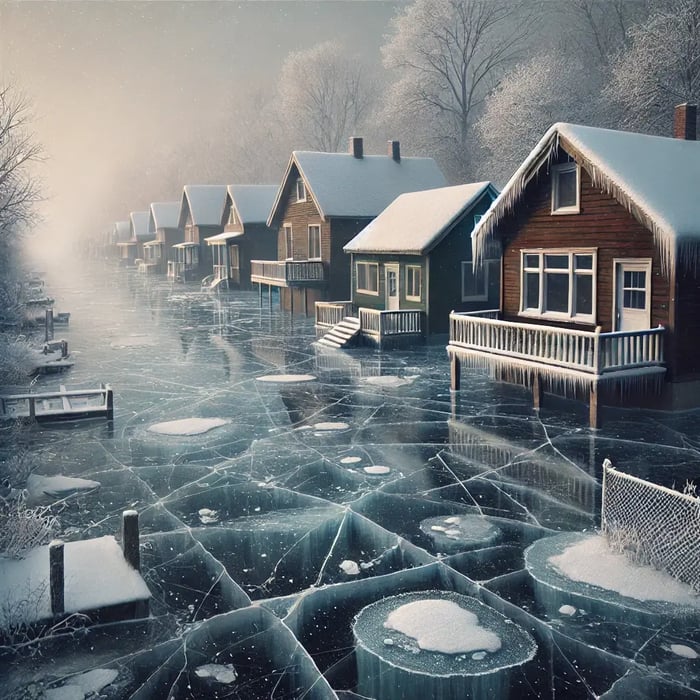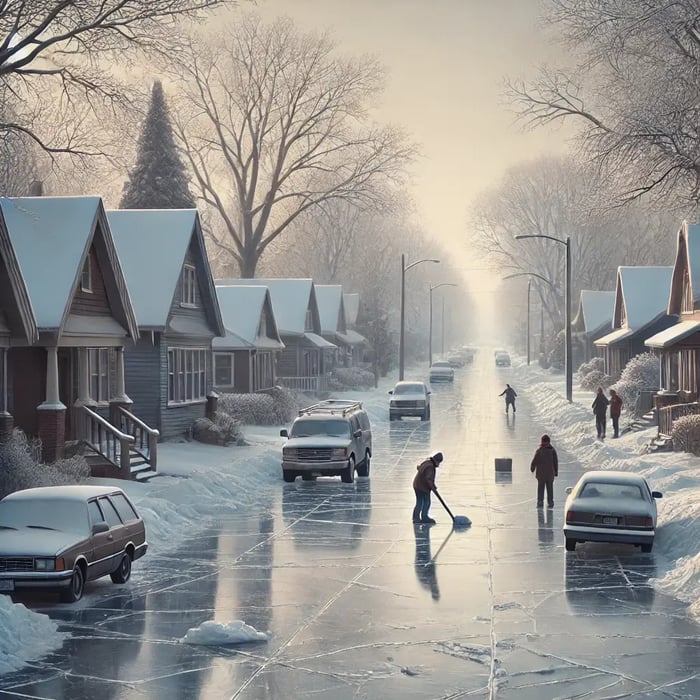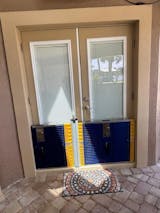Table of Contents
When winter's chill grips our communities, it brings more than just frosty mornings and cozy nights indoors. Frozen floodwaters can create hidden dangers that many homeowners and business owners might not expect. From the silent threat of ice jams to the unexpected damage from frozen drainage systems and rapid thaw floods, understanding these risks is key to protecting your property and ensuring your safety.
In many parts of the United States—places like Kentucky, which has recently experienced its fair share of flood challenges, as well as other areas known for harsh winter conditions—these issues are a reality. Whether you’re dealing with the biting cold of mid-February or the unpredictable weather of early May, it’s important to know what to watch out for and how to prepare.
In this article, we’ll break down:
- Ice Jams: How they form, why they’re dangerous, and what you can do to spot potential problems.
- Frozen Drainage Systems: The hidden threat of clogged pipes and backup water, and tips on preventing costly damage.
- Rapid Thaw Floods: What happens when the cold snaps give way to sudden warmth, and how can this rapid change cause chaos.
- And finally, we’ll introduce Dam Easy Flood Barriers, a trusted solution that has proven its worth not just across the United States but internationally as well.
Let’s dive in and explore the insidious ways that frozen floodwaters can wreak havoc—and what steps you can take to safeguard your home or business.
Understanding Ice Jams and Their Risks
What Are Ice Jams?
An ice jam occurs when chunks of ice in rivers, streams, or drainage systems accumulate and block the natural flow of water. This buildup can cause water to back up rapidly, leading to flooding in areas that might not normally be at risk. Think of it like a clogged drain in your kitchen—only on a much larger and more dangerous scale.
Why Are Ice Jams Dangerous?
Ice jams can be deceptive. They often form slowly and silently until suddenly, the pressure builds, and water starts spilling over flood defenses. Some key risks include:
- Unexpected Flooding: The buildup of water behind an ice jam can quickly lead to significant flooding, sometimes in areas that aren’t usually flood-prone.
- Structural Damage: Buildings, roads, and bridges can suffer from the unexpected surge of water, leading to costly repairs.
- Safety Hazards: Ice jams can create treacherous conditions. Slippery roads, compromised bridges, and the risk of ice breaking off suddenly all contribute to potentially dangerous situations for drivers and pedestrians.
Key Warning Signs of an Ice Jam:
- Unusual Ice Formations: Look for odd, irregular clumps of ice in your local waterways.
- Slow Moving or Stagnant Water: When water isn’t flowing as it normally does, it could be a sign that ice is starting to block the channel.
- Changes in Water Levels: Rapid changes in water level, especially if the water seems to be “piling up,” can indicate that an ice jam is forming.
Tip: Keep an eye on local news and weather alerts during cold spells, as early warnings can give you a crucial heads-up to take necessary precautions.
Frozen Drainage Systems: A Hidden Threat
The Problem with Frozen Drainage
While ice jams capture a lot of attention, frozen drainage systems are an equally dangerous, yet often overlooked, issue. When temperatures plummet, the water in your drainage pipes and gutters can freeze, leading to blockages that prevent proper water flow. This can cause water to back up and seep into your home or business, leading to internal flooding.
How Frozen Drainage Systems Cause Damage
Frozen drainage can create a host of problems:
- Blockage of Water Flow: When drainage systems freeze, they’re unable to channel water away from your property. This stagnant water can lead to leaks and water damage.
- Increased Pressure: As water builds up behind frozen drains, it can put pressure on pipes, sometimes causing them to burst.
- Structural Damage: Over time, repeated freeze-thaw cycles can weaken the structural integrity of your building, leading to costly repairs.
Signs Your Drainage System Might Be Frozen:
- Water Backup in Basements: If you notice water pooling in your basement or lower levels, it might be due to blocked drainage.
- Cracked or Damaged Pipes: Regularly inspect visible pipes and drainage areas for signs of cracks or burst segments.
- Unusual Gutter Behavior: If gutters or downspouts seem clogged or unusually heavy, ice may be blocking their flow.
Preventative Measures:
- Insulate Pipes: Use pipe insulation to help prevent water from freezing in your drainage systems.
- Regular Maintenance: Clear gutters and drains regularly, especially before the onset of freezing temperatures.
- Professional Inspection: Consider having a professional check your drainage system before winter sets in to ensure everything is in good working order.
Rapid Thaw Floods: When Cold Turns to Chaos
What Are Rapid Thaw Floods?
Rapid thaw floods occur when temperatures suddenly rise, causing large amounts of accumulated ice and snow to melt all at once. This sudden surge of water can overwhelm drainage systems, natural watercourses, and flood defenses, leading to severe flooding in a very short amount of time.
Why Rapid Thaw Floods Are Especially Risky
Unlike gradual melting, a rapid thaw doesn’t give you much time to react. Here’s why they’re particularly dangerous:
- Unpredictability: Rapid thaw events can occur with little warning, leaving little time for preparation or evacuation.
- High Volume of Water: The sheer volume of water produced by a rapid melt can quickly overwhelm even well-maintained drainage systems.
- Erosion and Infrastructure Damage: The sudden flow of water can erode riverbanks and damage infrastructure like roads and bridges.
Warning Signs of a Rapid Thaw Flood:
- Sudden Temperature Spikes: Keep an eye on weather forecasts; an unexpected warm day in the middle of winter could be the trigger.
- Melt Ponds and Ice Pools: Large areas of standing water that form from melting ice can indicate that a rapid thaw is underway.
- Increased Water Flow: Streams and rivers that normally flow steadily may suddenly surge, signaling that a rapid thaw flood could be imminent.
Safety Tips During a Rapid Thaw:
- Stay Informed: Sign up for local weather alerts and monitor updates from emergency services.
- Avoid Flood-Prone Areas: If you live near a river or stream, be extra cautious during a rapid thaw event.
- Prepare to Evacuate: Have a plan in place for a quick evacuation if your area becomes flooded.
Dam Easy Flood Barriers: Your Reliable Flood Control Solution
No matter how prepared you are, sometimes nature throws us a curveball. This is where a trusted flood defense product like Dam Easy Flood Barriers can make all the difference. These barriers have been designed with efficiency and ease-of-use in mind, and they’re trusted by homeowners and business owners across the United States—and even internationally.
Flood Barrier Door Dam - Ultimate Flood Gate

€779,00
DAM EASY® FLOOD GATE - DOOR DAM Floods are becoming more common around the world. What was once a 100-year phenomenon is now a seasonal trend that homeowners must deal with. That’s EXACTLY why you need this Dam Easy Flood… Read More
Why Choose Dam Easy Flood Barriers?
Dam Easy Flood Barriers are more than just a temporary fix; they’re a robust, reliable solution for controlling floodwaters before they wreak havoc on your property. Here’s what sets them apart:
- Easy Installation: No complicated tools or professional help is needed in many cases. You can install these barriers quickly to protect your property when it matters most.
- Cost-Effective: Flood damage can lead to significant repair costs. Investing in Dam Easy Flood Barriers now can save you money and stress later.
- Proven Efficiency: These barriers have been successfully used in areas that face extreme weather conditions—places like Kentucky and other flood-prone regions—proving their worth time and again.
- Versatile Use: Whether you’re protecting your home or a business, these barriers can be adapted to a variety of settings and situations.
- International Success: Not only are they trusted in the U.S., but Dam Easy Flood Barriers have also been recognized worldwide for their reliability in flood control.
Key Features at a Glance:
- Durability: Made from high-quality materials that can withstand harsh weather conditions.
- User-Friendly: Designed with the average homeowner in mind—a simple setup means you’re never unprepared.
- Scalable Solutions: Whether you need to protect a small area or a large property, these barriers can be scaled to meet your needs.
- Rapid Deployment: When time is of the essence, these barriers can be deployed quickly to help mitigate flood damage.
How Dam Easy Flood Barriers Can Help You
Imagine the peace of mind of knowing that even if nature decides to throw a rapid thaw flood or an unexpected ice jam your way, you have a barrier ready to hold back the worst of it. With Dam Easy Flood Barriers, you’re not just buying a product—you’re investing in the safety and security of your property.
For homeowners and business owners in areas like Kentucky and beyond, this solution has proven to be a lifesaver. With their track record of successful deployment across various regions prone to cold weather and flooding, you can trust that these barriers will do what they promise.
Take Action Today:
- Learn More: Visit the Dam Easy Flood Barriers Product Family to see how this innovative solution can be tailored to your specific needs.
- Get in Touch: For more detailed information or to discuss how Dam Easy Flood Barriers can protect your property, please Contact Us.
Putting It All Together: Protecting Your Home and Business
Floods, especially those caused by frozen waters, are more than just a seasonal nuisance. They represent a significant threat that can lead to property damage, financial loss, and even personal injury. By understanding the hidden dangers of ice jams, frozen drainage systems, and rapid thaw floods, you’re taking a crucial first step toward effective floodproofing.
Recap: What You Need to Watch For
- Ice Jams: Look out for unusual ice formations and slow-moving water that signal potential blockages.
- Frozen Drainage Systems: Keep gutters, pipes, and drainage systems clear and insulated to prevent blockages that could lead to internal flooding.
- Rapid Thaw Floods: Stay alert for sudden temperature changes and the resulting surges in water flow that can overwhelm even the best drainage systems.
Your Action Plan for Flood Safety
- Stay Informed: Monitor local weather alerts, especially during winter months and transitional periods like mid-February and early May.
- Inspect Regularly: Conduct routine inspections of your property’s drainage systems, roof gutters, and nearby water sources.
- Invest in Flood Protection: Consider installing reliable flood control solutions such as Dam Easy Flood Barriers to safeguard your property from unexpected flood events.
- Have a Plan: Prepare an emergency response plan for your family or business to ensure everyone knows what to do in the event of a flood.
Additional Tips for Homeowners and Business Owners:
- Maintain Your Landscape: Ensure that the grading around your home directs water away from the foundation.
- Seal Your Foundation: Use waterproofing techniques and sealants to minimize water infiltration.
- Elevate Critical Equipment: If you’re a business owner, consider elevating electrical equipment and other vital assets to reduce the risk of water damage.
- Emergency Supplies: Keep an emergency kit on hand, including items like sandbags, which can help provide an extra layer of protection during a flood.
Flood protection isn’t just about reacting to disasters—it’s about planning ahead and taking proactive measures to minimize risk. Whether you’re dealing with the potential for ice jams, the threat of frozen drainage systems, or the unpredictable nature of rapid thaw floods, every step you take toward floodproofing your property is a step toward peace of mind.
Final Thoughts
Winter may bring its share of challenges, but with the right knowledge and tools, you can stay one step ahead of nature. The hidden dangers of frozen floodwaters are serious, but they’re not insurmountable. By understanding the risks, keeping a vigilant eye on your local weather conditions, and investing in effective solutions like Dam Easy Flood Barriers, you’re well-equipped to protect your home or business from the unexpected.
Remember, flood protection is not just for extreme events—it’s a year-round commitment to keeping your property safe. Whether you live in flood-prone areas like Kentucky or in any region where cold weather can turn perilous, taking action now can save you a lot of trouble down the road.
Stay Prepared, Stay Safe, and Invest in Reliable Protection!
For more information on how you can fortify your property against the hidden dangers of frozen floodwaters, be sure to visit the Dam Easy Flood Barriers Product Family page. If you have any questions or need personalized advice, please don’t hesitate to Contact Us. Our team is here to help you navigate the challenges of flood control and ensure that your home or business remains secure, no matter what the weather brings.





















